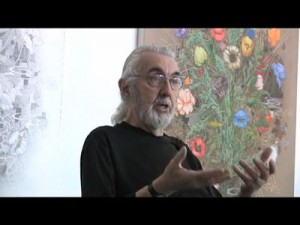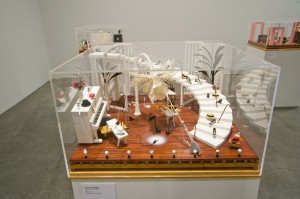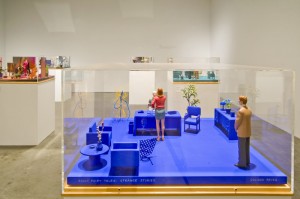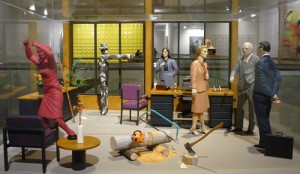A number of years ago, Roland Reiss gave me advice at one of my photography exhibits that I continue to use to this day. Sweeping his arm before my photographs, this former leader of Claremont University’s graduate art department said, “Rene, consider this whole thing as a big pizza; what you did is toss every known ingredient on it.” And I had! Now that doesn’t have to translate into a disaster unless, of course, you forget to organize all the disparate elements into a cohesive whole. I like to think those days are long gone for me.
Now it was my turn to gaze at some of Reiss’s past works entitled “Personal Politics: Sculpture from the 1970’s and 1980’s” (currently exhibited at the Pasadena Museum of California Art (PMCA) through January 8). And what do I see? Lots of sculptural diorama pizzas, seemingly cluttered with everything on them. Fortunately for Reiss, his “clutter” is extraordinarily organized both in form and in meaning; in other words, it worked brilliantly. I found myself much taken with this exhibit and couldn’t wait to meet up with my old friend to pose all sorts of questions about what I had seen. Here I share it with you:
Rene de Loffre – Look Roland, I walk into PMCA’s main exhibit space and the first thing I see is your life-size, monochromatic living room mock-up, much like I might see in a department store. The whole set up should have struck me as one big gimmick, yet it didn’t, I actually liked it a lot. Please tell me why I liked it?
Roland Reiss – First of all, Rene, you wouldn’t really see it in a department store or anywhere else. It is a life size model and as such it is an abstraction. You were walking around in a set of surrogate objects signifying our values and the way we live our lives. It is a language of objects describing middle class American life in the 70’s. I presume you liked it because you felt a certain familiarity, perhaps now somewhat nostalgic, for who we are and who we were for better and for worse. Hopefully, you enjoyed seeing and understanding our world and your place in it with some new insight.
RdL – I read that all of the various diorama series started as a reaction to a Colorado University campus murder?
RR – The dioramas began as a radical reaction to the progressivist, reductionist abstraction I was practicing in painting in the 60’s. I decided to fill my work with the content of my life and experience. I believe, with Wittgenstein, that artists produce the art society compels them to produce. In my case, I felt the need to bring an expressive viewpoint to the experience I shared with others. My art is for adults who have lived some and not primarily for young people or children. Many issues are very serious and the Dr. Strangelove type humor is meant to relieve the intensity. I thought a lot about Fellini, Bergman, Shakespeare and authors like Robbe-Grillet as a guide to dealing with levels of complexity and non-narrative approaches to ideas. My drawings about that murder in Colorado lead me to the idea of clues as a way of structuring the pieces providing a basis for spectator interaction. Later, clues became cues, and then after I discovered Umberto Ecco, signifiers.
RdL – I understand that you made a shift from figurative to abstract art and since I’ve known you, I’ve watched you make two distinctly different stylistic changes in your artwork. I admire your willingness to explore, but it can be rather risky to one’s artistic logo. Any regrets?
RR – Yes, I have changed my work radically a number of times. I have always believed we have many songs to sing. As artists and teachers today, we have seen so much more than artists in the past. It is all very interesting and exciting and one wants to test the dimensions of ones experience and creative capacity. Do I regret there is no signature style? Yes, but the adventure is so wonderfully challenging. In each case to bring something new to the human conversation is a thrill. If someone looks deeply enough into all of my work, they will find the same person, it’s me.
RdL– No matter what style you’re working in, to me your art always comes across as more intellectual than emotionally revealing of the artist. I always sense a layer between you the artist and me the viewer. No pun intended but you do experiment a lot with the placement of physical, transparent, and translucent layers in many of your works, any correlation here?
RR – I am a visual artist, interested above all in what Collingwood called “perceptual cognition.” That is, knowing through the eyes. You may be calling the formal structuring of my work intellectual. Actually, it is in the structural/visual coherence achieved that the deepest emotional presence of the artist is liberated. If by intellectual, you are referring to narrative reading of more overt subject matter, you will be missing the point that it is all about fractured, multiple scenarios and readings. I think the layer you refer to is the fact that the viewer must do a great deal of the work and has the responsibility to complete the many possible resolutions or be content to live in the state of incompleteness. I have always seen transparency and translucency as view planes composed of the different densities through which we engage experience. Some things are foggy and some are crystal clear. Qualities of light and vision affect the illumination of ideas, presenting them in different ways. In the simplest terms, it’s all expressive “show and tell” and the key to it is visual perception.
RdL – O.K., let’s get into the specificity of your dioramas. You really pull the viewer into each work, I was totally absorbed and when I looked around I noticed that everyone else was as captured as I was. It was a real voyeuristic trip where you created a world of the familiar that transfigured into a world of the unfamiliar- a “twilight zone” sort of world frozen between action and inaction. Each diorama world is full of ambiguous, even incongruous, juxtaposing of objects and subjects. One encounters realism next to fantasy, completion alongside the uncompleted, and the obvious mingled with the “where ‘s Waldo”. How much of your environments are whimsy, theatricality or tongue-in-cheek situations? How much is a serious attempt to create situational narratives?
RR– Let’s start with the fact that the dioramas are very serious. In the 60’s some of us laced our art with humorous asides to “help the medicine go down.” This must be seen in context because there is virtually no humor in the art of this moment. The pieces involve multiple, incomplete narrative elements meant to resonate within an individual piece and with every piece in the series. Each series does chart out a different territory, each with wide ranging, but related meanings. You are right on in the substance of your question. Incongruity, ambiguity and juxtaposition are key strategies among many in the work. In finding these, you must have gotten into the work where I want you to be. You get the overview from above and four side views, then you project yourself into it, explore it mentally, you are the performer. I am asking everyone to make that leap.
RdL– The amount of work that went into these dioramas is quite staggering, did you do it all yourself or with a cadre of helpers?
RR – Yes, making these things was a staggering amount of work and delayed gratification, with staying up till 4:00 in the morning quite often. As I began to have some success, I hired “Rolaids” numbering 12 over the later years.
RdL- One last question. When I look at your dioramas, either large-scale or miniature, I can’t but think of Rene Magritte’s surrealistic play of scale along with a good measure of animism; that is, the objects are loaded with human associations that can live with or without a human presence. Is this coincidental or a meaningful part of your creative attempt here?
RR– You know, Matisse talked about elements of a still life as characters acting out a drama on a tabletop. I have always felt that
objects were imbedded with personal and social meanings and that they stood in for us in many life situations and contexts. Clearly, we are the ones who breathe life into objects, forms, ideas and art. My friend, Clyfford Still said that, “A painting is an instrument for creating a meaning.” I would add that the viewer has to do half the work.
RdL- I really have to hand it to you Roland, I shamefully underestimated your art, in fact, you make really great pizzas. Thanks for a great viewing experience and interview.
RR– Thanks for your interest in my show. It will be up until January 8, 2012






It was good to see this posting and I enjoyed the interview very much. Roland has always been so eloquent and specific about art–his own and others’. A great example of an artist doing vital work in his eighties. An inspiration.
Well written and well worthwhile reading.
Thanks,
Karen
I appreciate your insightful and intelligent writing, Rene.
Elizabeth
As usual, interesting and informative. I just wish I could zoom into the photos, they are so small it’s hard, at least for me, to see what is going on and get the impact.
Inspiring exchange. I love reading discussions that make me want to run into my studio and change things up. Thanks!